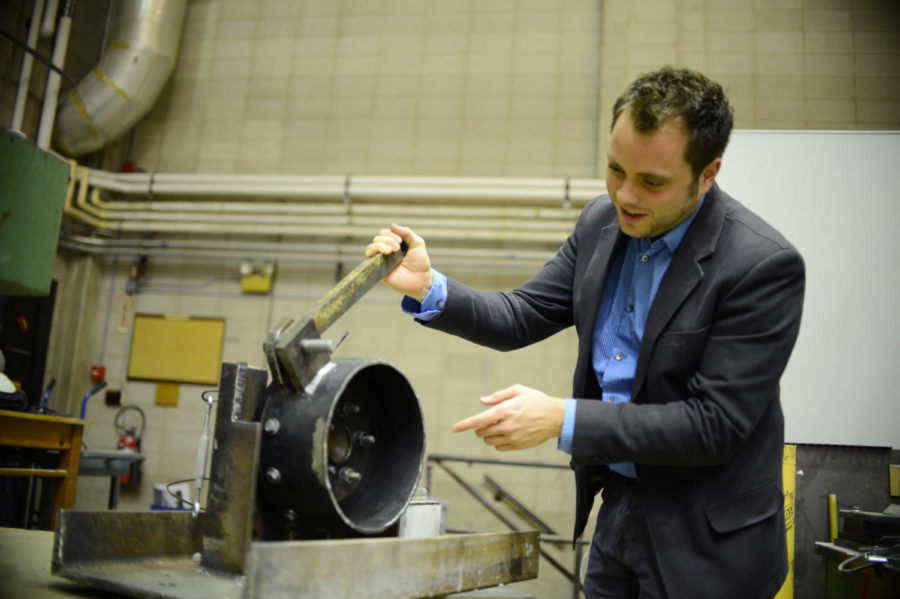New damping system puts brake on building movement
Photo: Huiling Wu/Iowa State Daily
Simon Laflamme, assistant professor of civil, construction and environmental engineering, shows a sample of his project about car brakes, which starts in May 2013.
April 24, 2013
Research is set to begin this summer for a system, inspired by car brake technology, that is designed to both decrease damage and increase usability for buildings during wind and seismic events.
The research and ideation, aided by a grant from the National Science Foundation, originated from Simon Laflamme, a civil, construction and environmental engineering assistant professor at Iowa State.
One factor that led to Laflamme’s idea was, in part, due to changes in the compositions of buildings.
“The problem we have with excitation, like earthquakes or high winds or even moderate winds, is that a structure moves,” Laflamme said. “Nowadays, with advancements in materials, structures become lighter, so they move even more than they used to.”
The movement of buildings can cause damage and dysfunction to buildings, as well as even possible sickness for occupants, a condition called Sick Building Syndrome.
“We need to find a way to dampen, or reduce, those movements in the structures,” Laflamme said. “So if you have an earthquake, you don’t want the structure to move too much or you can have damage.”
In efforts to achieve this goal, inspiration was drawn from none other than a car brake.
“A car goes very fast,” Laflamme said. “It’s a big mass with a lot of energy, so you want to dampen your energy by pressing the pedal. If you could convert that idea to civil structures, then perhaps there’s a way we can resist a lot of force in a structure using a low amount of energy.”
The device, referred to as a semi-active damping system, would be able to detect building motion, which then triggers an electronic signal directed toward a brake that would act in dampening the building’s movement.
To test the semi-active dampening system, smaller scale tests will be run at the Town Engineering building with the assistance of undergraduate and graduate students.
“Once we can show the prototype works [on smaller scales], then we’ll be fine to go with the larger scale tests where, probably in the future, we’ll be able to put that in a part of a building and show that it will work,” Laflamme said.
Current passive viscous dampers are currently implemented in some buildings, but the use of a semi-active damper, one that runs on electricity or a back-up battery, could be more impactful.
“We can reinvent these devices and incorporate some sort of flexibility in the device and change the capacity of the damper to damp,” Laflamme said.
Not only can dampening capabilities be enhanced, but efficiency could also increase.
“The [preliminary] simulation showed that the new system we proposed would cut down on the number of dampers to a third of what they installed,” Laflamme said.
The simulation also showed that upwards of $200,000 in installation costs could be saved per building.
To test the device on a larger scale in the coming years, Lehigh University will provide assistance.
Also, throughout the research process, Laflamme’s research group will be in mentorship with Taylor Devices, a company based on providing shock and vibration control devices.
“One of my fortes is bringing concepts that are known to mechanical engineers into the field of civil and structural engineering,” said Doug Taylor, chief executive officer of Taylor Devices.
In regards to the application of Laflamme’s system, Taylor spoke to its applicability going forward.
“Simon’s concept is very applicable to limiting the motion of a building under both wind events and earthquakes, enabling a safer structure for the least amount of cost,” Taylor said.

















